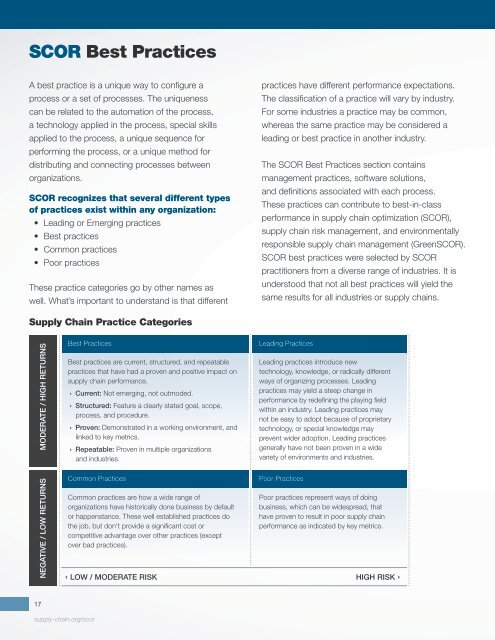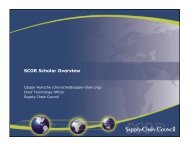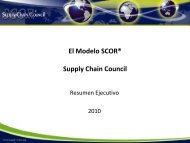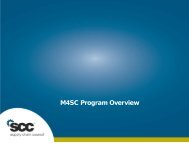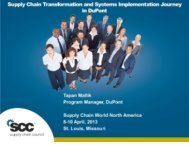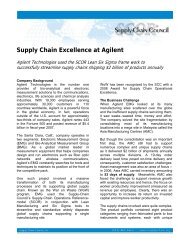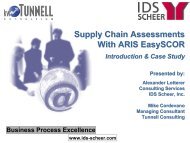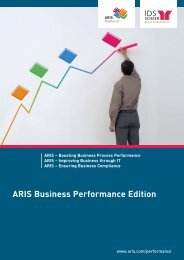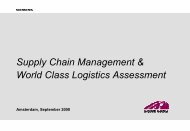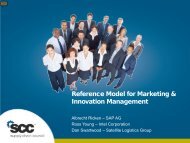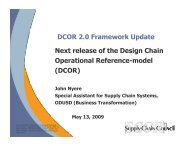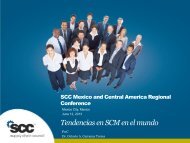SCOR Overview - Supply Chain Council
SCOR Overview - Supply Chain Council
SCOR Overview - Supply Chain Council
You also want an ePaper? Increase the reach of your titles
YUMPU automatically turns print PDFs into web optimized ePapers that Google loves.
<strong>SCOR</strong> Best Practices<br />
A best practice is a unique way to configure a<br />
process or a set of processes. The uniqueness<br />
can be related to the automation of the process,<br />
a technology applied in the process, special skills<br />
applied to the process, a unique sequence for<br />
performing the process, or a unique method for<br />
distributing and connecting processes between<br />
organizations.<br />
<strong>SCOR</strong> recognizes that several different types<br />
of practices exist within any organization:<br />
• Leading or Emerging practices<br />
• Best practices<br />
• Common practices<br />
• Poor practices<br />
These practice categories go by other names as<br />
well. What’s important to understand is that different<br />
practices have different performance expectations.<br />
The classification of a practice will vary by industry.<br />
For some industries a practice may be common,<br />
whereas the same practice may be considered a<br />
leading or best practice in another industry.<br />
The <strong>SCOR</strong> Best Practices section contains<br />
management practices, software solutions,<br />
and definitions associated with each process.<br />
These practices can contribute to best-in-class<br />
performance in supply chain optimization (<strong>SCOR</strong>),<br />
supply chain risk management, and environmentally<br />
responsible supply chain management (Green<strong>SCOR</strong>).<br />
<strong>SCOR</strong> best practices were selected by <strong>SCOR</strong><br />
practitioners from a diverse range of industries. It is<br />
understood that not all best practices will yield the<br />
same results for all industries or supply chains.<br />
<strong>Supply</strong> <strong>Chain</strong> Practice Categories<br />
MODERATE / HIGH RETURNS<br />
Best Practices<br />
Best practices are current, structured, and repeatable<br />
practices that have had a proven and positive impact on<br />
supply chain performance.<br />
› Current: Not emerging, not outmoded.<br />
› Structured: Feature a clearly stated goal, scope,<br />
process, and procedure.<br />
› Proven: Demonstrated in a working environment, and<br />
linked to key metrics.<br />
› Repeatable: Proven in multiple organizations<br />
and industries.<br />
Leading Practices<br />
Leading practices introduce new<br />
technology, knowledge, or radically different<br />
ways of organizing processes. Leading<br />
practices may yield a steep change in<br />
performance by redefining the playing field<br />
within an industry. Leading practices may<br />
not be easy to adopt because of proprietary<br />
technology, or special knowledge may<br />
prevent wider adoption. Leading practices<br />
generally have not been proven in a wide<br />
variety of environments and industries.<br />
NEGATIVE / LOW RETURNS<br />
Common Practices<br />
Common practices are how a wide range of<br />
organizations have historically done business by default<br />
or happenstance. These well established practices do<br />
the job, but don't provide a significant cost or<br />
competitive advantage over other practices (except<br />
over bad practices).<br />
Poor Practices<br />
Poor practices represent ways of doing<br />
business, which can be widespread, that<br />
have proven to result in poor supply chain<br />
performance as indicated by key metrics.<br />
NEGATIVE / LOW RETURNS<br />
‹ LOW / MODERATE RISK HIGH RISK ›<br />
17<br />
supply-chain.org/scor


